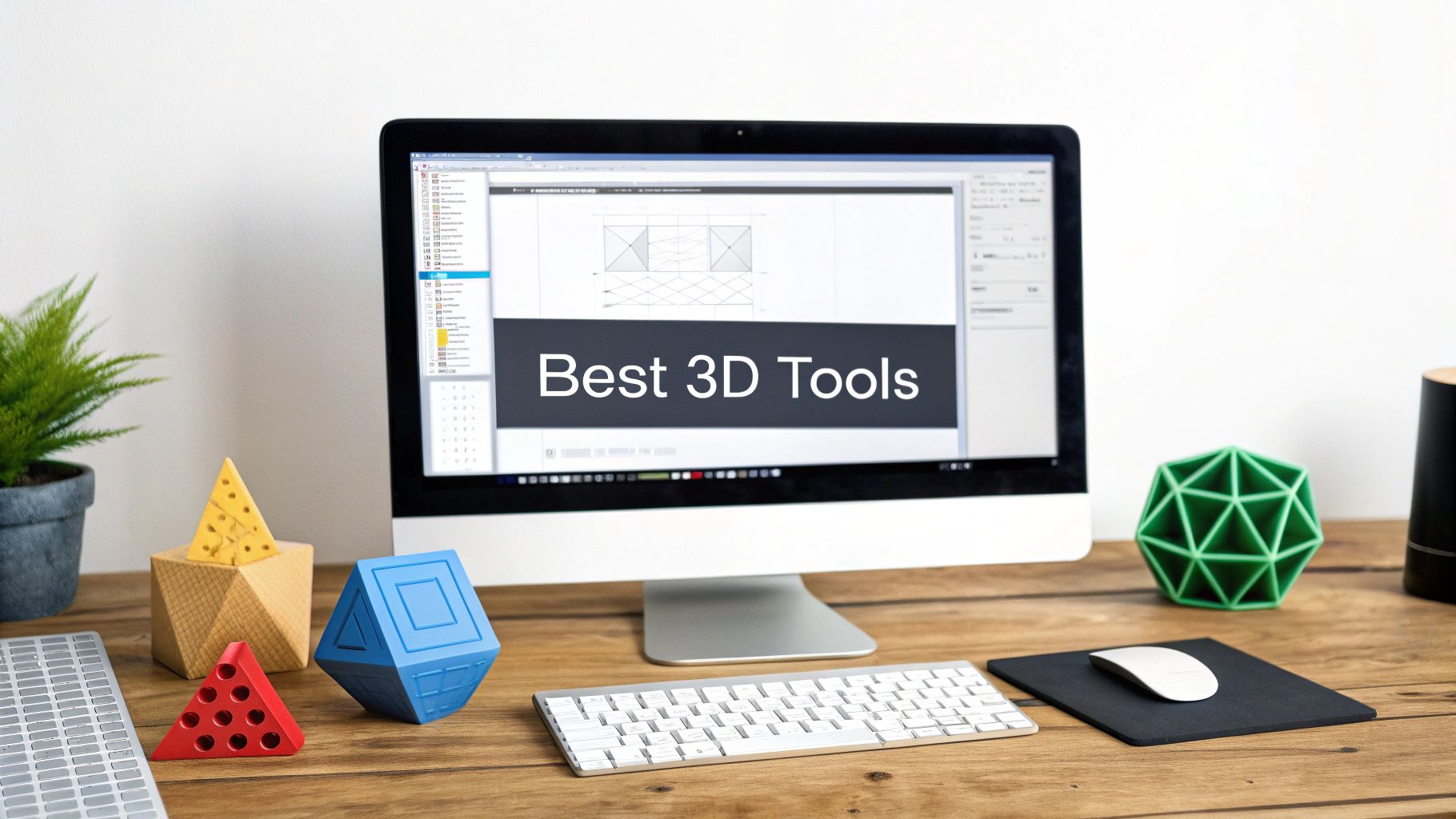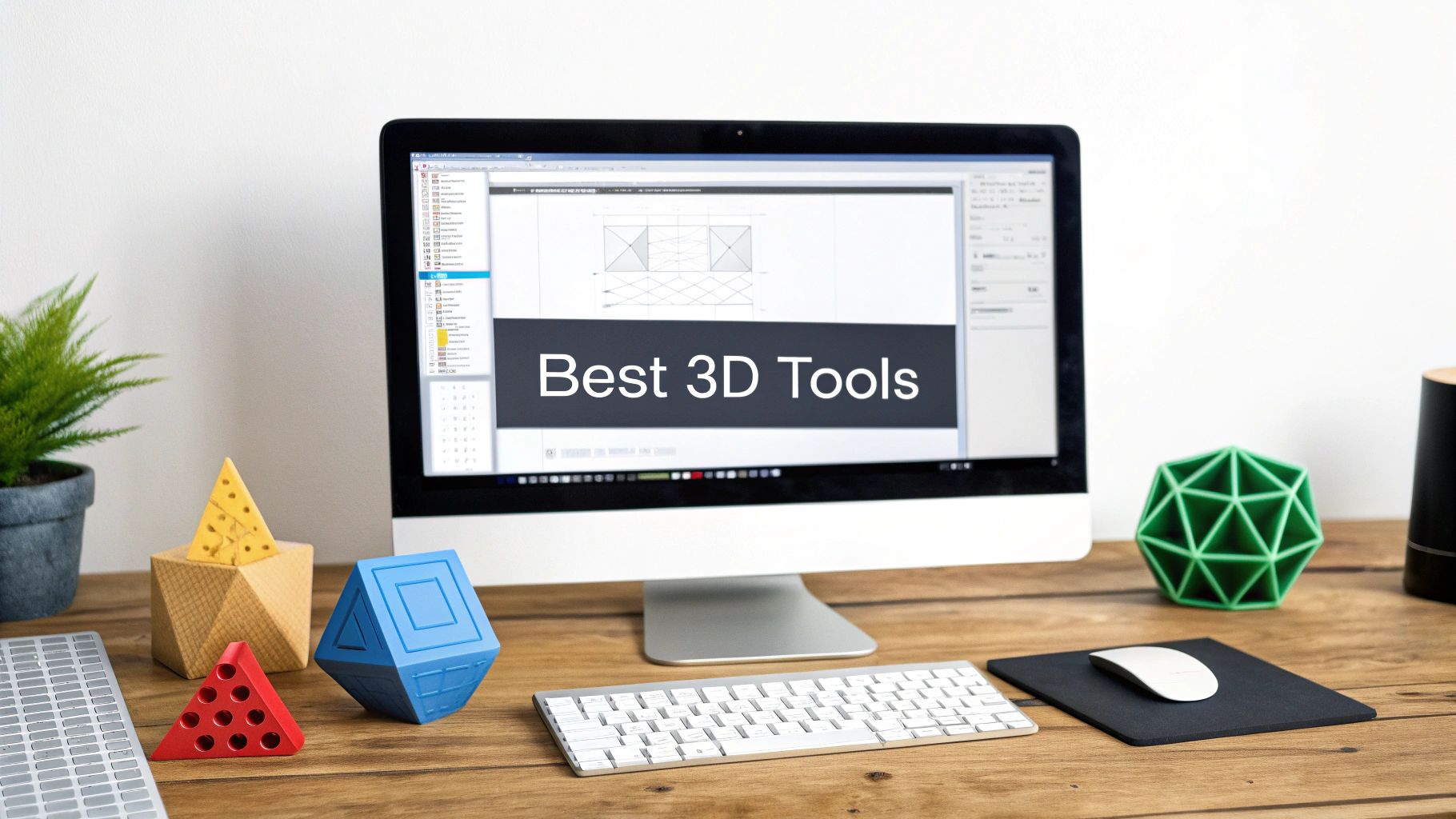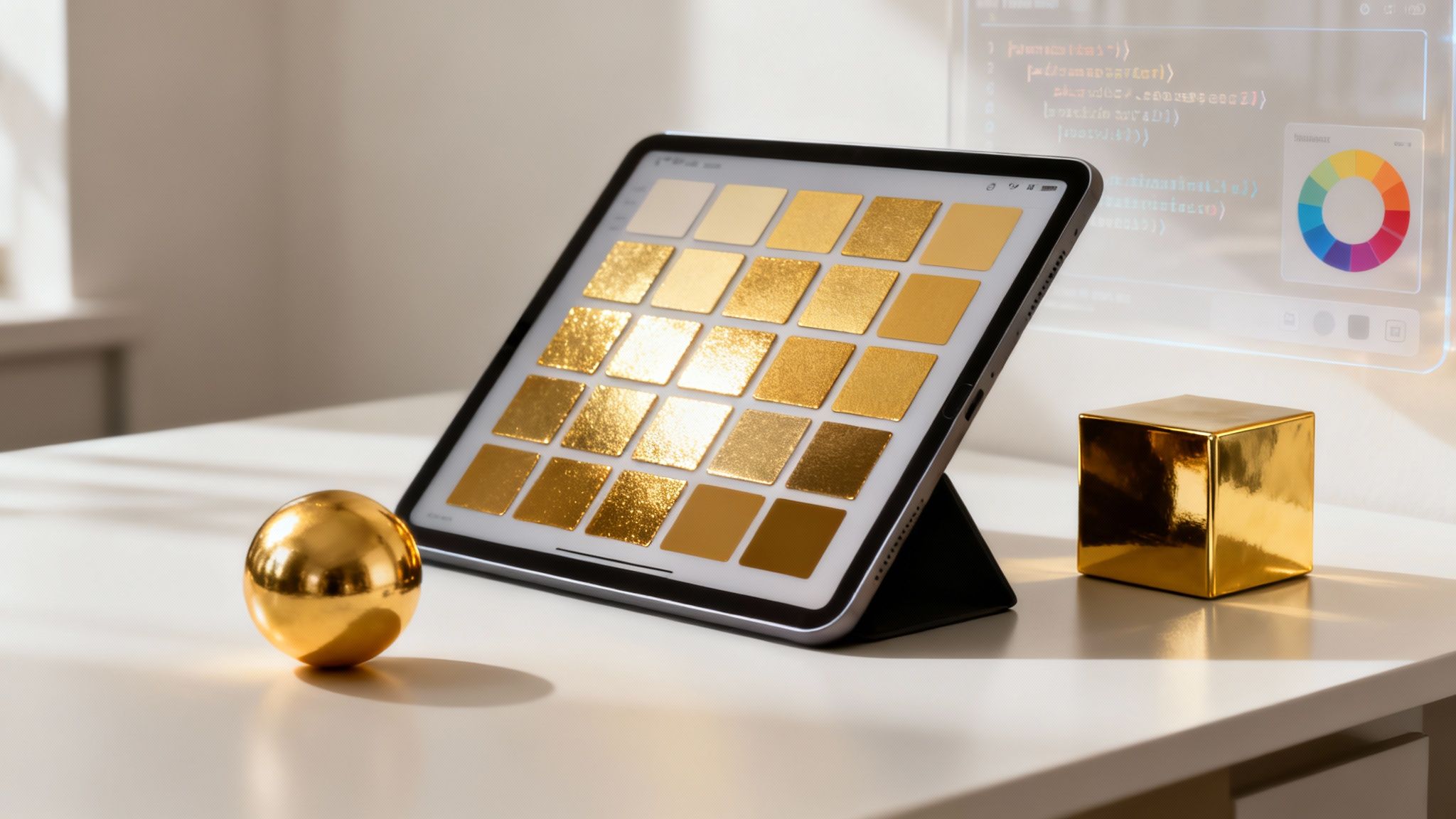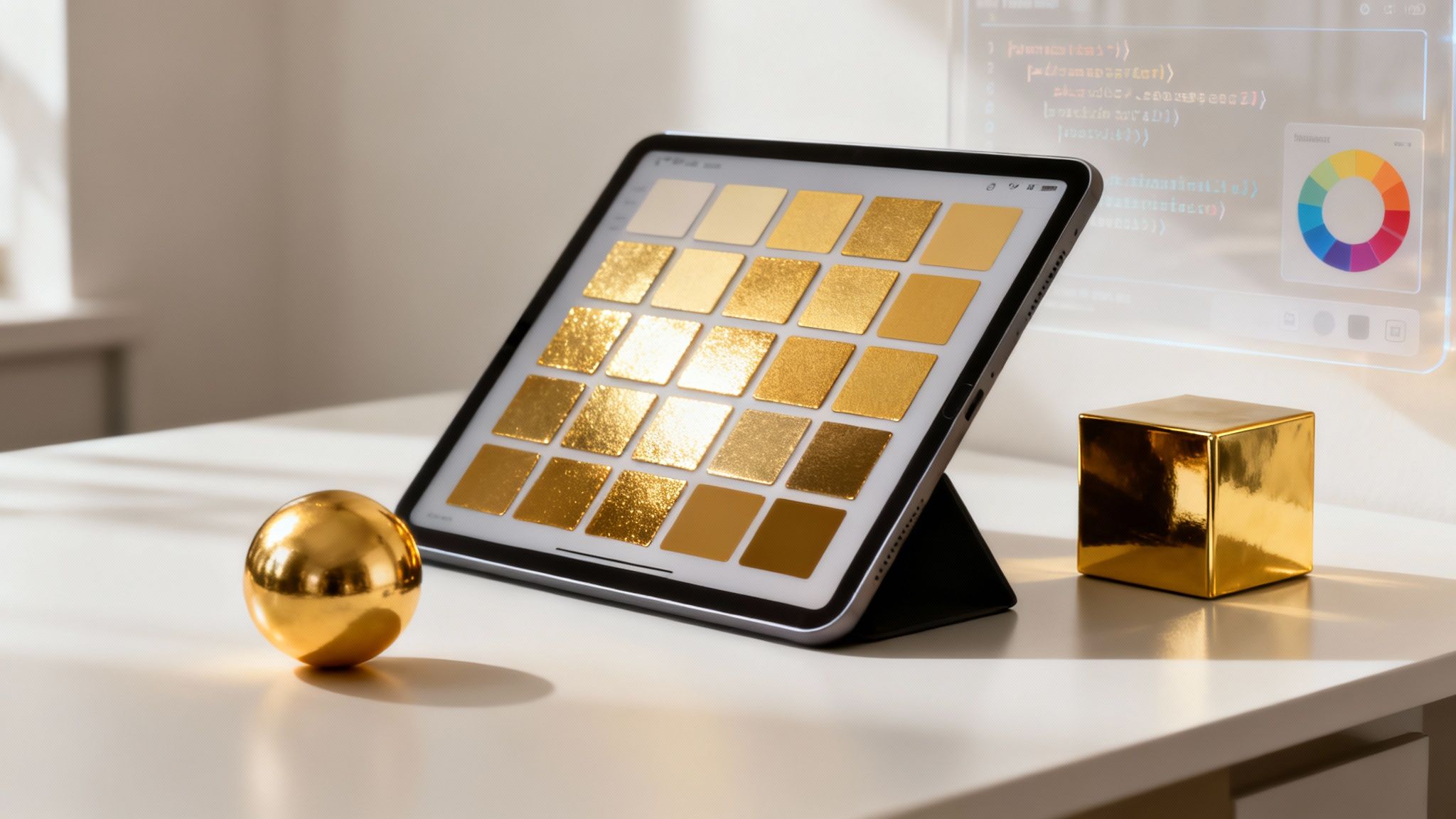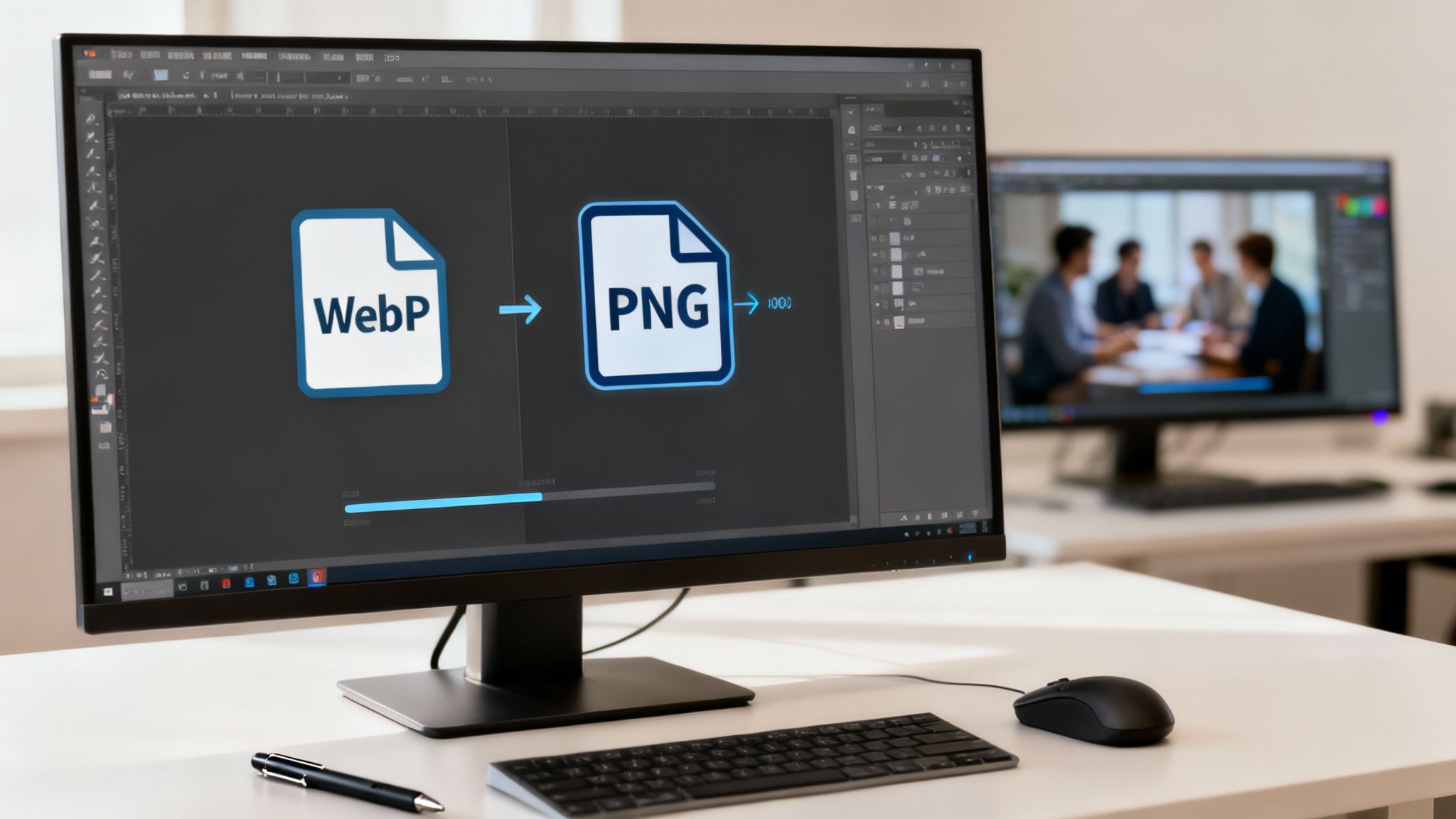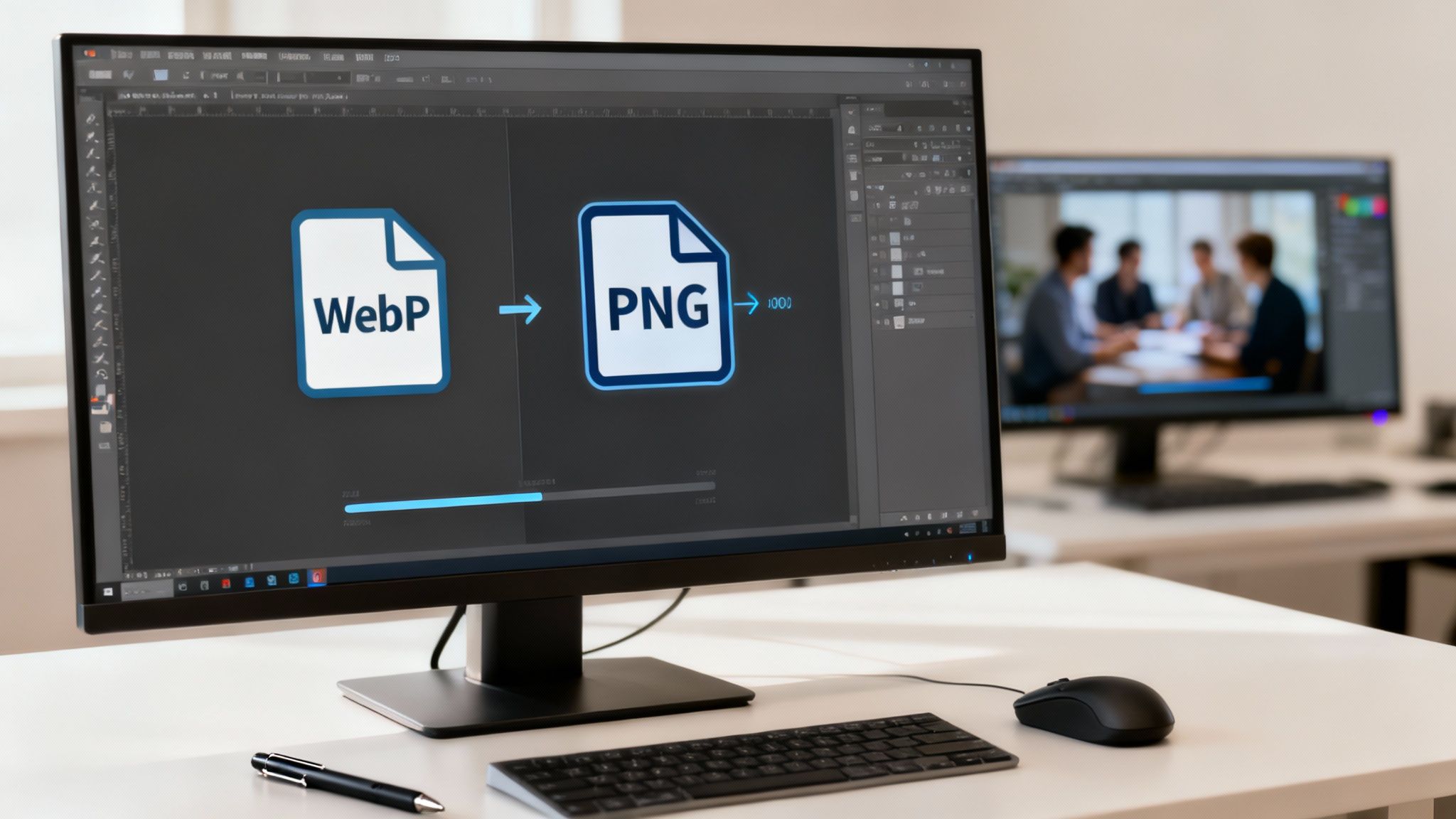Selecting your first 3D modeling software is a decision that should align with your specific objectives. For projects related to 3D printing or the creation of simple models, a tool such as Tinkercad provides an excellent entry point, enabling users to begin creating with minimal delay. However, for those aspiring to work in animation, game design, or visual effects, Blender stands as the industry-standard, open-source solution, though it requires a more significant commitment to learning.
Top Beginner 3D Modeling Software at a Glance
To facilitate your decision-making process, the following table provides a summary of our recommended software. This overview details the primary application for each tool, its pricing structure, and a score for its suitability for new users.
Software NamePrimary Use CasePricing ModelBeginner Friendliness Score (1-5)Tinkercad3D Printing, Simple Models, EducationFree5BlenderAnimation, Game Assets, VFX, SculptingFree & Open Source3SketchUpArchitecture, Interior Design, WoodworkingFreemium4
Consider this table a reference guide. We will now explore the factors that make these tools—and your selection—so important.
Choosing Your First 3D Modeling Software
Entering the field of 3D modeling can be a complex undertaking, similar to learning a new technical language. The market offers dozens of software options, each with unique features, workflows, and interfaces, which can be challenging to navigate.
The key to a successful start is to match the software's capabilities to your project goals. Are you designing functional parts for a 3D printer? Creating character models for a game? Visualizing an architectural space? The most effective software is the one that helps you achieve your specific objective most efficiently.
We will compare the leading options based on criteria essential for new users:
- Ease of Use: How quickly can you become productive without being hindered by a complex interface?
- Project Focus: Is the software optimized for technical design, artistic sculpting, or a combination of disciplines?
- Learning Resources: Are high-quality tutorials and a supportive user community available to assist you?
- Cost and Scalability: Can you begin with a free version and scale your usage as your skills develop?
Comparing Beginner Friendliness
The initial learning curve is often the most significant challenge for new users. An intuitive tool promotes motivation and progress, whereas an overly complex one can lead to frustration.
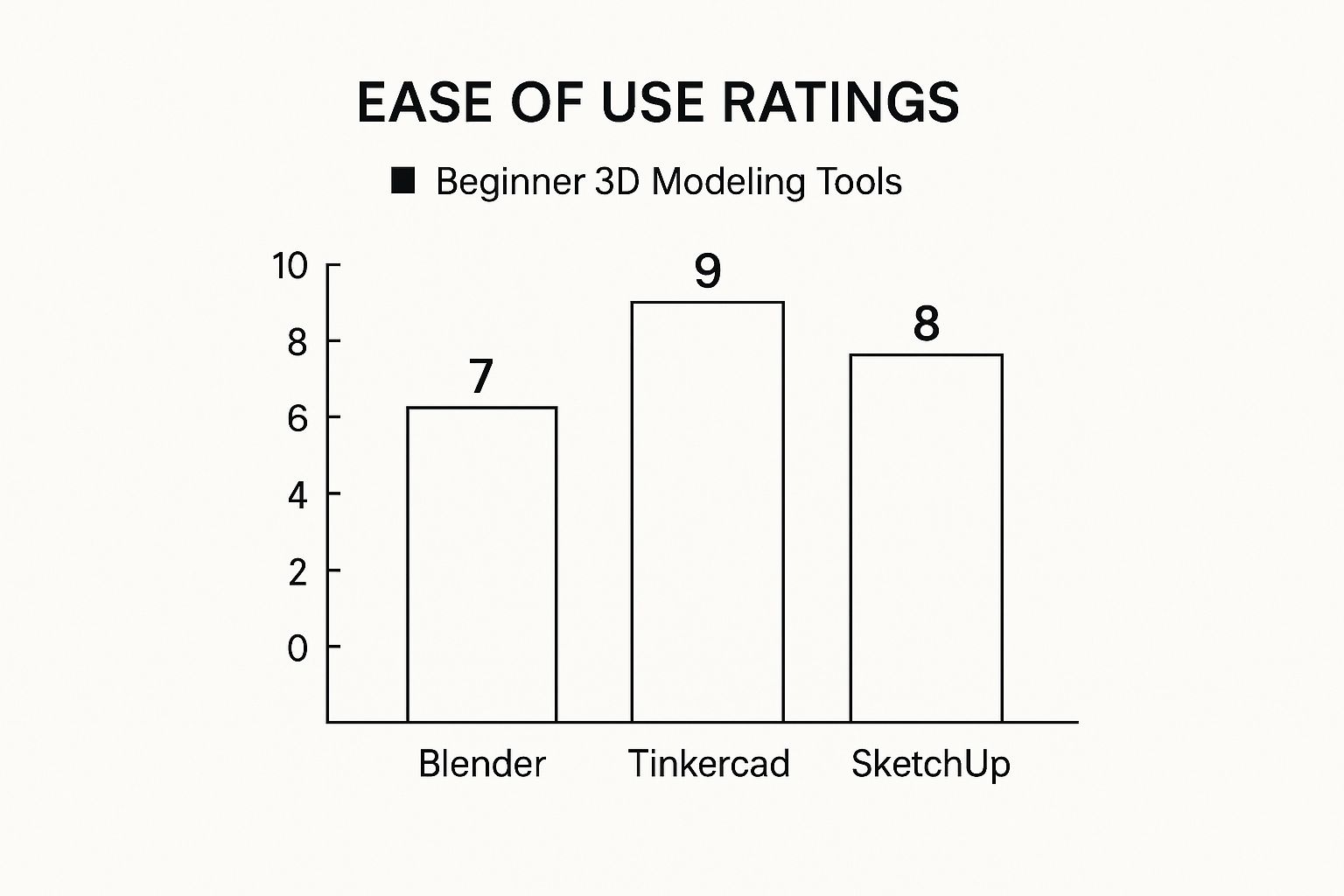
As illustrated, tools like Tinkercad are designed for immediate use. More powerful software such as Blender requires a greater time investment, but it offers substantial long-term benefits.
The demand for 3D skills is growing rapidly across media, architecture, and manufacturing. The global market for 3D modeling software was valued at approximately $33.3 billion and is projected to reach $65.5 billion by 2033. However, data indicates that around 42% of new users find it difficult to start with 3D software without structured training.
Choosing the right starting point is not about finding the "best" software in an absolute sense—it is about finding the software that is best suited for your needs. An intuitive tool builds confidence, while a confusing one can impede progress.
Setting a Foundation for Success
Your initial software choice is more than a single decision; it establishes the foundation for your entire journey in 3D design. To ensure you make an informed choice, it is beneficial to first understand the fundamental principles of the field.
Our complete guide on 3D modeling for beginners covers the core concepts and workflows you need to know. It will assist you in selecting a tool that not only matches your current skill level but also supports your future professional growth.
Evaluating Free Software for New Designers
When starting out, the landscape of free 3D software offers two distinct pathways. One is a comprehensive suite offering extensive creative freedom but requiring a significant time investment to master. The other provides a more focused and straightforward toolset that allows you to start creating in minutes. The objective is not to determine which is superior, but to identify the appropriate choice for your current requirements.
This decision often centers on two widely-used options: Blender and Tinkercad. They address fundamentally different needs, and selecting the correct one at the outset can significantly impact your learning experience. Let's analyze this choice with practical context.
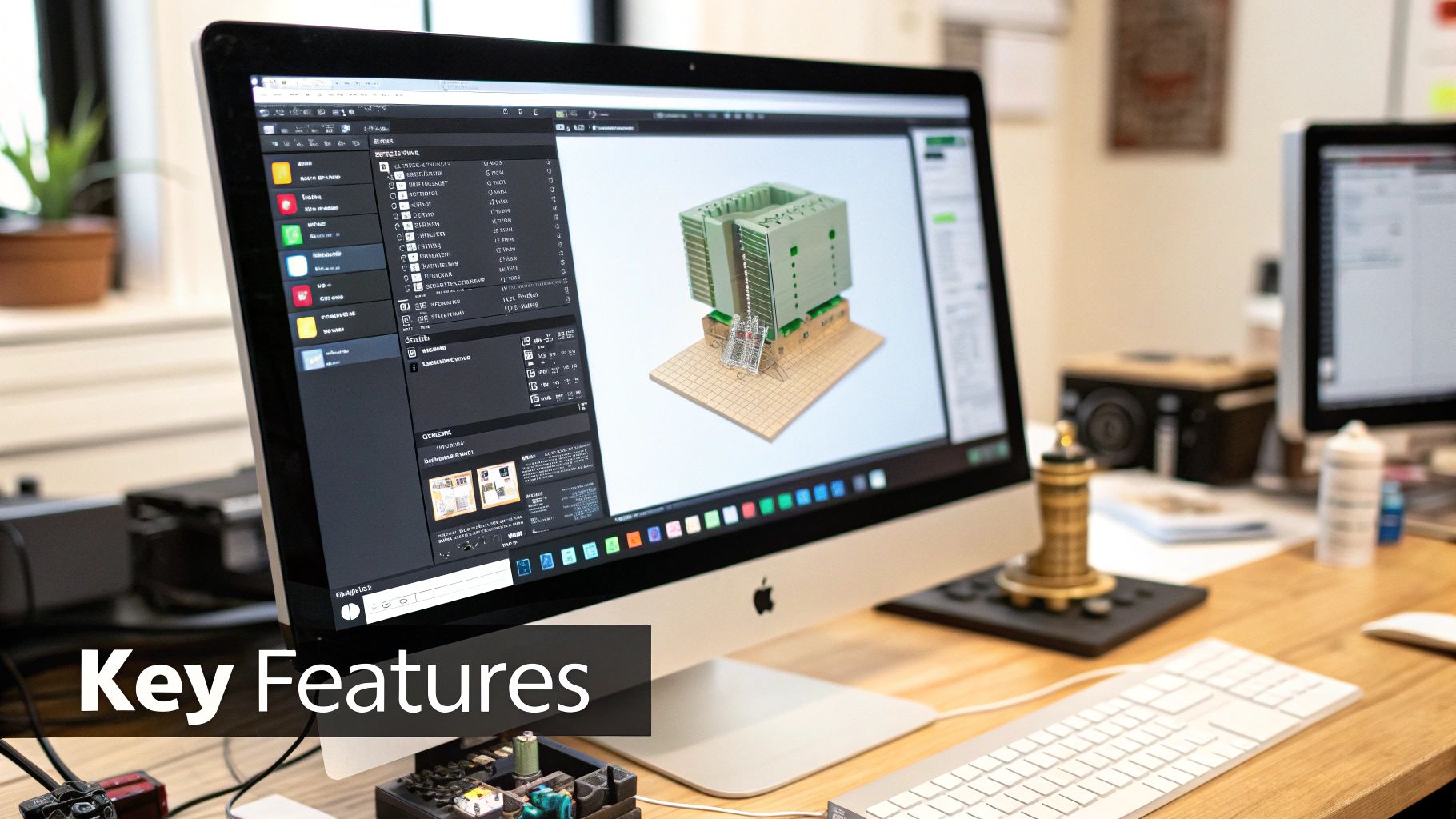
Tinkercad: The Accessible Starting Point
Autodesk's Tinkercad was developed with accessibility as its primary goal. It operates entirely within a web browser, requiring no installation and functioning on nearly any computer. This makes it a secure and convenient option, particularly for educational settings or for users who prefer not to download new software.
The workflow is based on a simple principle: you combine and subtract primitive shapes—such as cubes, spheres, and cylinders—to construct more complex designs. This approach is analogous to working with digital building blocks, which removes the technical intimidation often associated with 3D modeling.
Key Insight: Tinkercad's primary advantage is its minimal learning curve. A user can progress from a blank workspace to a 3D-printable model in less than an hour, making it ideal for 3D printing, simple prototyping, and educational projects.
Consider a practical task like designing a custom phone stand. In Tinkercad, you would start with a rectangular block, add a wedge shape to create the angle, and then use another shape to subtract the slot for the phone. The process is direct, visual, and focused on achieving a tangible result quickly.
Blender: The Professional Powerhouse
At the other end of the spectrum is Blender. It is a completely free and open-source suite that provides a comprehensive range of functionalities, including modeling, sculpting, animation, visual effects, and even video editing. It is a preferred tool for freelancers, independent game developers, and even major studios.
However, this extensive power is accompanied by complexity. While the Blender interface has become more user-friendly over time, the learning curve remains steep. Users must become familiar with abstract concepts such as vertices, edges, faces, modifiers, and nodes.
Using our phone stand example but with a more artistic application—sculpting a simple fantasy character—the process in Blender is quite different. You would begin with a basic sphere and utilize digital sculpting brushes to pull, push, smooth, and crease the mesh to form the character. The creative freedom is nearly limitless but requires a solid understanding of form, anatomy, and the software's extensive toolset.
A Situational Comparison
Your choice should be based not only on your long-term ambitions but also on the immediate task at hand. A beginner aspiring to become a character artist might still benefit from starting with Tinkercad to grasp the fundamentals of 3D space in a low-pressure environment.
Here is a brief breakdown to guide your decision:
- For designing a custom keychain: Tinkercad is the superior choice due to its speed and efficiency in creating functional objects for a 3D printer.
- For creating a low-poly game asset: Blender is the necessary tool. Its polygonal modeling tools, UV unwrapping, and texturing features are essential for any game development workflow.
- For a middle school STEM project: Tinkercad offers a secure, controlled, and easy-to-teach environment, allowing students to focus on design rather than software complexity.
- For an animated short film: Blender is an all-in-one solution. You can model, rig, animate, and render your final film within a single application.
This model of providing powerful, free entry points is common in many creative fields. For instance, some of the best free video editing software for beginners empowers new creators without a significant financial investment. Your choice in 3D software should follow the same logic: select the tool that enables you to learn and create without being hindered by unnecessary complexity.
When to Consider Paid Software for Long-Term Growth
While free software provides an excellent starting point, there are circumstances where investing in a paid tool is a strategic decision for long-term growth. This transition is not merely about accessing additional features; it is about committing to a professional-grade environment designed for specific industry workflows.
Paid platforms typically offer increased efficiency, dedicated technical support, and seamless integrations with other professional tools in exchange for a subscription fee. This can be viewed as an investment in your own productivity. For those aiming to transition from a hobbyist to a professional, this is a step worth considering.
SketchUp: Intuitive Modeling for Architecture and Design
SketchUp has earned its reputation for its "push/pull" modeling method, which feels more like drawing than traditional 3D modeling. This intuitive approach has made it a standard tool for architects, interior designers, and woodworkers.
If you are designing a room layout or a new piece of furniture, SketchUp allows for rapid visualization. You draw a 2D shape, pull it into a 3D form, and instantly see your idea realized. This immediate feedback is highly motivating for new users.
SketchUp's strength lies in its simplicity. It is engineered to create hard-surface models and architectural concepts without the overwhelming complexity of other programs, offering a direct path from sketch to detailed 3D design.
Fusion 360: Integrated CAD for Product Development
Autodesk Fusion 360 is a fundamentally different type of software, designed for engineering, product design, and manufacturing. As a true CAD (Computer-Aided Design) program, its core focus is precision. It is the optimal choice for beginners who intend to design functional parts for 3D printing or CNC machining.
Unlike mesh modelers such as Blender, Fusion 360 utilizes a parametric workflow. Each action is recorded in a timeline. If a dimension needs to be changed, you can go back and edit the value, and the rest of the model will update automatically. This feature is essential for iterative product design.
Fusion 360 also includes integrated CAM (Computer-Aided Manufacturing) tools, which allow you to prepare your designs for CNC machines within the same application. It serves as an all-in-one platform for creating physical products.
Market data supports the value of such tools. The global 3D CAD software market was valued at approximately USD 11.73 billion and is projected to reach USD 19.15 billion by 2032. A significant portion of this growth is driven by cloud-based tools like Fusion 360, which make powerful engineering software more accessible. You can review the 3D CAD market growth data to see how cloud technology is creating opportunities for new designers.
ZBrushCoreMini: A Gateway to Digital Sculpting
For individuals interested in creating characters or organic models, ZBrush is a renowned name in the industry. While the full version is a professional standard, ZBrushCoreMini offers a free introduction to its powerful digital sculpting workflow. It is an ideal primer before considering an upgrade to its affordable counterpart, ZBrushCore.
Unlike the technical precision of Fusion 360 or the architectural lines of SketchUp, ZBrushCoreMini focuses on organic creation. It provides a limited set of essential brushes and a digital clay medium, allowing you to learn the fundamentals of sculpting without being overwhelmed by menus.
So, how do these paid options compare for specific projects?
- Designing a custom bookshelf for your workshop? SketchUp is the most suitable choice, as it is specifically designed for this type of architectural and woodworking project.
- Creating a replacement gear for a broken appliance? Fusion 360 is the correct tool. Its parametric capabilities are essential for producing functional, precise mechanical parts.
- Sculpting a stylized creature for your portfolio? ZBrushCore (the paid upgrade from Mini) provides the specialized sculpting tools required for detailed organic work.
Ultimately, investing in paid software is about aligning your tools with your professional ambitions. Each of these platforms offers a focused, well-supported environment designed to help you specialize and grow in your chosen field.
Understanding Core 3D Modeling Features
Entering the world of 3D can be like learning a new technical discipline. You will encounter terms like "polygonal modeling," "sculpting," "texturing," and "rendering." Understanding these concepts is the first step toward selecting the right tool for your creative goals.
Think of these features as different instruments in a workshop. You would not use a paintbrush to sculpt clay, nor a chisel to paint a canvas. Each feature serves a specific function in the process of creating a digital object.
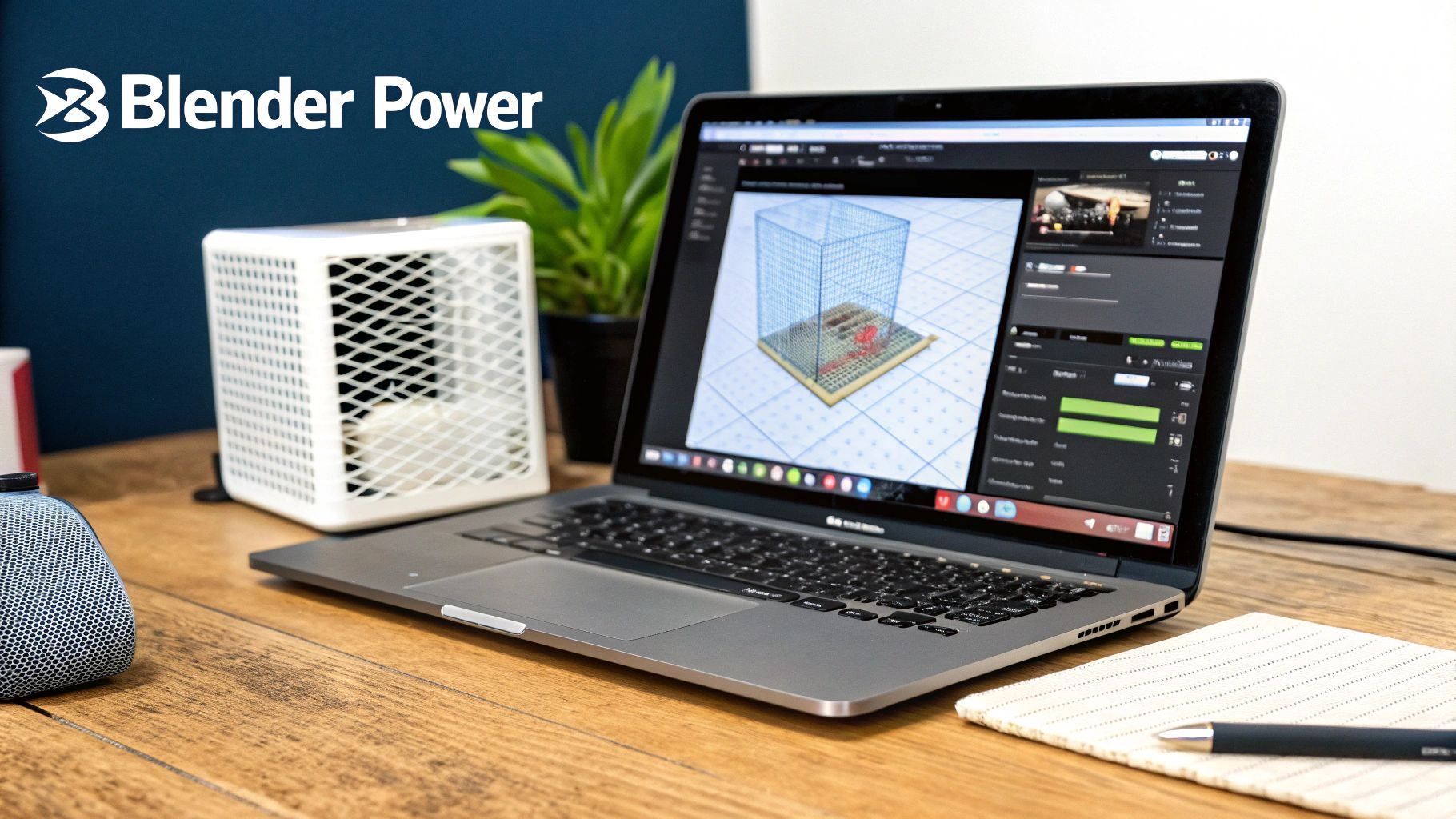
Polygonal Modeling: The Building Blocks of 3D
At its core, much of 3D modeling is polygonal modeling. This technique involves constructing objects from a mesh of points, lines, and surfaces. The individual points are called vertices, the lines connecting them are edges, and the flat surfaces they form are faces (or polygons).
This method is the foundation for creating nearly any object with clean, defined surfaces, such as game assets, architectural visualizations, and product designs. Software like Blender and SketchUp excel at this approach. For example, to create a simple table, you would begin with a cube and then manipulate its faces to form the tabletop and legs.
The central principle of polygonal modeling is precision and control. It is analogous to digital carpentry, where you carefully shape and assemble components to construct a final object.
Digital Sculpting: Shaping Digital Clay
While polygonal modeling is structured, digital sculpting is an artistic and expressive process. Instead of manipulating individual points and lines, you push, pull, smooth, and pinch a high-density mesh as if it were a piece of digital clay.
This technique is ideal for creating organic shapes with intricate details, such as characters, creatures, and natural landscapes. ZBrushCoreMini is a great free tool for exploring this workflow. The process is fluid and intuitive, allowing you to focus on form and detail rather than the underlying technical geometry. New technologies are also making a significant impact in this area; you can learn more about how generative AI is changing the future of 3D design and how it is automating parts of this creative process.
Texturing and Rendering: Bringing Your Model to Life
Once your 3D model is complete, the next steps are to apply surface details and create a final image. This is where texturing and rendering are employed.
- Texturing is the process of applying a 2D image (a texture) to your 3D model to give it color, detail, and material properties. This can turn a simple gray sphere into a realistic basketball or a rusty metal barrel.
- Rendering is the final step in which the software calculates how light interacts with the objects in your scene—including shadows, reflections, and materials—to generate a final 2D image. It is the virtual equivalent of taking a photograph of your creation.
The demand for these skills is increasing rapidly. The North American market alone constitutes 34.69% of global revenue in this sector, and the availability of user-friendly tools is enabling more beginners to enter the field. You can find more statistics on the 3D design software market on cognitivemarketresearch.com.
Feature Comparison Across Top Beginner Software
No single software excels at every task; each has its specific strengths. A tool designed for 3D printing may not require advanced rendering capabilities, while an animation suite would be incomplete without them. Understanding these distinctions will help you make a more informed choice.
Here is a brief overview of how popular beginner-friendly tools handle these core features.
FeatureBlenderTinkercadSketchUpFusion 360Polygonal ModelingExtremely powerful; industry-standard toolsBasic; combines pre-made shapesExcellent for architecture and clean linesStrong; focused on engineering precisionDigital SculptingBuilt-in, robust sculpting modeNot availablePossible with extensions, but limitedVery limited; not its primary functionTexturingAdvanced node-based system for realismSimple color and material applicationEasy to apply textures, good for conceptsRealistic material library for simulationRenderingTwo powerful built-in engines (Eevee & Cycles)Basic, non-photorealistic renderingBasic built-in renderer; needs plugins for realismCloud-based photorealistic rendering
This comparison makes it clear that your project's requirements should guide your decision. If your goal is to create detailed characters, a tool with strong sculpting capabilities like Blender is essential. However, if you simply need to design a part for a 3D printer, Tinkercad's simplicity is sufficient. This knowledge allows you to look beyond marketing and focus on the functionalities you will actually use.
Matching Software to Your Project Goals
Selecting your first 3D modeling tool is not about finding a single "best" option; it is about matching the software's capabilities to your intended application. A tool that is ideal for architectural models may be inefficient for sculpting characters.
Let's move beyond generalized advice and examine the most common project paths for beginners. By understanding the typical workflows for each, you can select a tool that is well-suited to your needs and supports your success from the start.
The Hobbyist Creating for 3D Printing
If your objective is to create physical objects with a 3D printer, you need software that excels at producing printable models. This requires simplicity, precision, and the ability to export files that are ready for printing without extensive technical adjustments.
- Top Recommendation: Tinkercad. This browser-based tool is the leading choice for those new to 3D printing. Its methodology is based on combining and subtracting simple shapes to create more complex models. It is fast, intuitive, and offers the most direct path from an idea to a printable file.
- Why It Works: Tinkercad is designed to produce "watertight" models, which is a critical requirement for successful 3D prints. This eliminates the need to troubleshoot complex geometry issues that can often cause print failures. It is the most efficient way to get a physical object from a digital design.
For projects that require greater precision, such as mechanical parts, Fusion 360 is the logical next step. Its free personal license provides access to parametric modeling, which is essential for designing functional components like gears or custom enclosures where precise dimensions are critical.
The Aspiring Game Artist
To create assets for video games, you will need a versatile tool that can handle the entire production pipeline: modeling, sculpting, UV unwrapping, texturing, and exporting to a game engine. Your software must be capable of creating a wide range of assets, from hard-surface props like weapons to organic characters.
- Top Recommendation: Blender. This free, open-source software has become a powerful tool in the games industry. It is widely used by independent developers and is also incorporated into the workflows of major studios. Blender provides a complete pipeline for creating game-ready assets.
- Why It Works: Learning Blender provides you with valuable, transferable skills for a career in game development. It integrates well with popular game engines like Unreal and Unity, making it a cost-effective and strategic choice for building a professional portfolio.
Key Takeaway: For game art, versatility is paramount. Blender offers a comprehensive, end-to-end solution that can grow with your skills and prepare you for the technical and artistic demands of the gaming industry.
The Future Architect or Interior Designer
If your interests lie in designing buildings, planning interior spaces, or woodworking, your software needs will be different. The emphasis is on scale, spatial relationships, and clear presentation. The right tool should feel like an extension of sketching, allowing you to quickly mock up floor plans and structures.
- Top Recommendation: SketchUp Free. SketchUp’s well-known "Push/Pull" tool makes 3D modeling feel exceptionally intuitive. It is ideal for blocking out architectural concepts, designing room layouts, and creating detailed models without becoming overly technical.
- Why It Works: SketchUp is highly effective at creating clean, hard-surface designs at an architectural scale. Furthermore, its extensive 3D Warehouse provides access to millions of free models—such as furniture, windows, and doors—that you can import directly into your scenes to accelerate your workflow. It is the best way to visualize physical spaces quickly.
The Product Design Student
If you are passionate about designing consumer products—from electronics to furniture—you need software that combines artistic form with engineering function. The key concept here is parametric design, a workflow that allows you to make precise changes that intelligently update your entire model.
- Top Recommendation: Fusion 360. It is the modern standard for product design and is available for free for personal, non-commercial use. Its parametric workflow is essential for design iteration, enabling you to adjust concepts based on exact measurements and constraints.
- Why It Works: Fusion 360 is more than a modeler; it is an integrated CAD/CAM/CAE tool. This means you can design a product, simulate its performance, and prepare it for manufacturing, all within a single platform. Understanding this workflow provides a significant advantage for a career in industrial design.
As your skills advance, you will begin to manage larger projects. To learn how professional teams handle this, see our guide on creative operations for 3D and how modern teams manage content at scale. It is also important to understand the potential applications of these skills; learning how virtual reality training solutions are driving results demonstrates one of many powerful uses for 3D modeling.
Frequently Asked Questions
Beginning your journey in 3D modeling can present many questions. Obtaining clear answers at the outset will help you select the right software and start your work with confidence.
Here, we address the most common concerns of beginners, offering practical advice to help you get started.
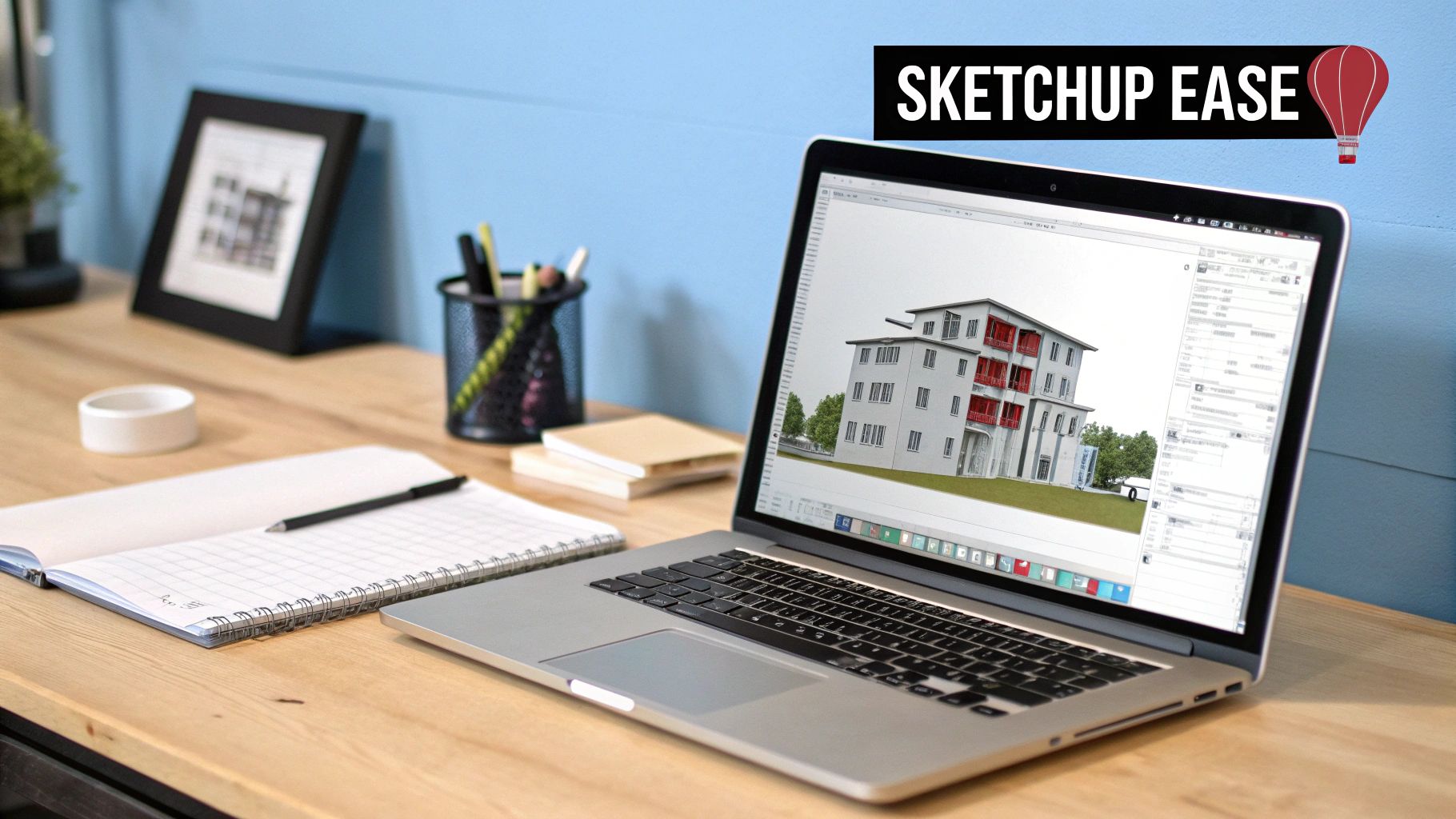
Do I Need a Powerful Computer for 3D Modeling?
When you are just starting, a high-performance computer is generally not required. Many of the best beginner tools, such as Tinkercad, operate directly in your web browser. This allows you to learn the fundamentals on almost any modern computer without needing to invest in new hardware.
The requirements change as you advance to more demanding software like Blender. While it is possible to use such programs on a mid-range machine, performance may degrade as your projects increase in complexity.
For a smooth experience with advanced tools, the following specifications are a good baseline:
- A modern quad-core CPU
- A dedicated graphics card (GPU) with at least 4GB of VRAM
- 16GB of RAM or more
This configuration provides sufficient power for most beginner-to-intermediate projects without causing frustrating delays, allowing you to focus on developing your skills rather than being limited by your hardware.
What Is the Best Way to Learn 3D Modeling?
The most effective way to learn is through hands-on practice. Instead of passively watching tutorials, actively follow along, pausing and repeating steps as needed. This approach helps build procedural memory and a genuine understanding of the software.
Begin with the official tutorials provided by the software developer, as they are structured to introduce core features logically. Once you have mastered the basics, seek out project-based courses where you create a complete object from start to finish.
The key to proficiency in 3D modeling is consistency, not intensity. A few focused hours of practice each week will yield better results than a single, lengthy session once a month. It is steady practice that solidifies your understanding.
Can I Build a Career Using Free 3D Software?
Yes, absolutely. The fact that a software is free does not diminish its professional viability. A powerful tool like Blender is not just for students; it is used by freelancers, independent game studios, and even large creative agencies in their professional pipelines.
What matters most to employers is the quality of your portfolio and your demonstrated skills, not the specific software you used to create your work.
The core competencies you develop—such as polygonal modeling, sculpting, texturing, and rendering—are transferable across different programs. A strong portfolio filled with high-quality work is more persuasive than a software license. It proves you have the artistic vision and technical ability required for a professional role.
Should I Learn 2D Design Before 3D Modeling?
While not a strict prerequisite, having a background in 2D design is a significant advantage. An understanding of 2D principles like form, perspective, color theory, and composition translates directly to creating compelling 3D work. It can help you sketch ideas more effectively and make stronger artistic decisions.
However, if you do not have a 2D background, do not let that deter you. Many successful 3D artists learn these fundamentals as they progress. You can begin your 3D journey today and build your artistic instincts concurrently with mastering the technical aspects of the software.
Accelerate your creative workflow with Virtuall, the AI-powered platform designed to help your team generate, manage, and deliver 3D models faster than ever. Transform text and images into high-quality 3D assets in seconds and streamline your entire production pipeline. Discover how we can support your creative vision by visiting https://virtuall.pro.

